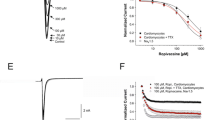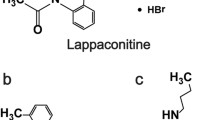Abstract
Bupivacaine ranks as the most potent and efficient drug among class I local anesthetics, but its high potential for toxic reactions severely limits its clinical use. Although bupivacaine-induced toxicity is mainly caused by substantial blockade of voltage-gated sodium channels (VGSCs), how these hydrophobic molecules interact with the receptor sites to which they bind remains unclear. Nav1.5 is the dominant isoform of VGSCs expressed in cardiac myocytes, and its dysfunction may be the cause of bupivacaine-triggered arrhythmia. Here, we investigated the effect of bupivacaine on Nav1.5 within the clinical concentration range. The electrophysiological measurements on Nav1.5 expressed in Xenopus oocytes showed that bupivacaine induced a voltage- and concentration-dependent blockade on the peak of I Na and the half-maximal inhibitory dose was 4.51 μmol/L. Consistent with other local anesthetics, bupivacaine also induced a use-dependent blockade on Nav1.5 currents. The underlying mechanisms of this blockade may contribute to the fact that bupivacaine not only dose-dependently affected the gating kinetics of Nav1.5 but also accelerated the development of its open-state slow inactivation. These results extend our knowledge of the action of bupivacaine on cardiac sodium channels, and therefore contribute to the safer and more efficient clinical use of bupivacaine.
Similar content being viewed by others
References
Brown DL, Ransom DM, Hall JA, Leicht CH, Schroeder DR, Offord KP. Regional anesthesia and local anesthetic-induced systemic toxicity: seizure frequency and accompanying cardiovascular changes. Anesth Analg 1995, 81: 321–328.
Graf BM. The cardiotoxicity of local anesthetics: the place of ropivacaine. Curr Top Med Chem 2001, 1: 207–214.
Ragsdale DS, McPhee JC, Scheuer T, Catterall WA. Molecular determinants of state-dependent block of Na+ channels by local anesthetics. Science 1994, 265: 1724–1728.
Valenzuela C, Sanchez-Chapula J. Electrophysiologic interactions between mexiletine-quinidine and mexiletineropitoin in guinea pig papillary muscle. J Cardiovasc Pharmacol 1989, 14: 783–789.
Gonzalez T, Longobardo M, Caballero R, Delpon E, Tamargo J, Valenzuela C. Effects of bupivacaine and a novel local anesthetic, IQB-9302, on human cardiac K+ channels. J Pharmacol Exp Ther 2001, 296: 573–583.
Catterall WA. Cellular and molecular biology of voltage-gated sodium channels. Physiol Rev 1992, 72: S15–48.
Catterall WA. Structure and function of voltage-gated ion channels. Annu Rev Biochem 1995, 64: 493–531.
Candenas L, Seda M, Noheda P, Buschmann H, Cintado CG, Martin JD, et al. Molecular diversity of voltage-gated sodium channel alpha and beta subunit mRNAs in human tissues. Eur J Pharmacol 2006, 541: 9–16.
Nau C, Wang SY, Strichartz GR, Wang GK. Point mutations at N434 in D1-S6 of mu1 Na(+) channels modulate binding affinity and stereoselectivity of local anesthetic enantiomers. Mol Pharmacol 1999, 56: 404–413.
Nau C, Wang SY, Wang GK. Point mutations at L1280 in Nav1.4 channel D3-S6 modulate binding affinity and stereoselectivity of bupivacaine enantiomers. Mol Pharmacol 2003, 63: 1398–1406.
Valenzuela C, Snyders DJ, Bennett PB, Tamargo J, Hondeghem LM. Stereoselective block of cardiac sodium channels by bupivacaine in guinea pig ventricular myocytes. Circulation 1995, 92: 3014–3024.
Wilde AA, Brugada R. Phenotypical manifestations of mutations in the genes encoding subunits of the cardiac sodium channel. Circ Res 2011, 108: 884–897.
Wang Q, Shen J, Splawski I, Atkinson D, Li Z, Robinson JL, et al. SCN5A mutations associated with an inherited cardiac arrhythmia, long QT syndrome. Cell 1995, 80: 805–811.
Eckardt L, Kirchhof P, Loh P, Schulze-Bahr E, Johna R, Wichter T, et al. Brugada syndrome and supraventricular tachyarrhythmias: a novel association? J Cardiovasc Electrophysiol 2001, 12: 680–685.
Laitinen-Forsblom PJ, Makynen P, Makynen H, Yli-Mayry S, Virtanen V, Kontula K, et al. SCN5A mutation associated with cardiac conduction defect and atrial arrhythmias. J Cardiovasc Electrophysiol 2006, 17: 480–485.
Sakura S, Bollen AW, Ciriales R, Drasner K. Local anesthetic neurotoxicity does not result from blockade of voltage-gated sodium channels. Anesth Analg 1995, 81: 338–346.
Kindler CH, Yost CS. Two-pore domain potassium channels: new sites of local anesthetic action and toxicity. Reg Anesth Pain Med 2005, 30: 260–274.
Liu ZR, Tao J, Dong BQ, Ding G, Cheng ZJ, He HQ, et al. Pharmacological kinetics of BmK AS, a sodium channel site 4-specific modulator on Nav1.3. Neurosci Bull 2012, 28: 209–221.
Chen HW, yang HT, Zhou JJ, Ji YH, Zhu HY. Pharmacological modulation of brain Nav1.2 and cardiac Nav1.5 subtypes by the local anesthetic ropivacaine. Neurosci Bull 2010, 26: 289–296.
Lenkowski PW, Shah BS, Dinn AE, Lee K, Patel MK. Lidocaine block of neonatal Nav1.3 is differentially modulated by co-expression of beta1 and beta3 subunits. Eur J Pharmacol 2003, 467: 23–30.
Bean BP, Cohen CJ, Tsien RW. Lidocaine block of cardiac sodium channels. J Gen Physiol 1983, 81: 613–642.
Gristwood RW. Ca rdiac and CNS toxicity of levobupivacaine: strengths of evidence for advantage over bupivacaine. Drug Saf 2002, 25: 153–163.
Clarkson CW, Hondeghem LM. Mechanism for bupivacaine depression of cardiac conduction: fast block of sodium channels during the action potential with slow recovery from block during diastole. Anesthesiology 1985, 62: 396–405.
Burlacu CL, Buggy DJ. Update on local anesthetics: focus on levobupivacaine. Ther Clin Risk Manag 2008, 4: 381–392.
Hanck DA, Nikitina E, McNulty MM, Fozzard HA, Lipkind GM, Sheets MF. Using lidocaine and benzocaine to link sodium channel molecular conformations to state-dependent antiarrhythmic drug affinity. Circ Res 2009, 105: 492–499.
Ulbricht W. Sodium channel inactivation: molecular determinants and modulation. Physiol Rev 2005, 85: 1271–1301.
Author information
Authors and Affiliations
Corresponding authors
Additional information
These authors contributed equally to this work.
Rights and permissions
About this article
Cite this article
Zhang, H., Ji, H., Liu, Z. et al. Voltage-dependent blockade by bupivacaine of cardiac sodium channels expressed in Xenopus oocytes. Neurosci. Bull. 30, 697–710 (2014). https://doi.org/10.1007/s12264-013-1449-1
Received:
Accepted:
Published:
Issue Date:
DOI: https://doi.org/10.1007/s12264-013-1449-1




